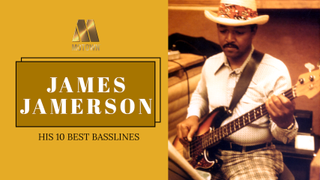From 1958 through to 1972 the studio musicians at Motown Records, who later became known as The Funk Brothers, cranked out hit after hit. In fact, they played on more number 1 records than the Beatles, the Rolling Stones, Elvis and the Beach Boys put together, all while remaining mostly anonymous.
One thing evident on every recording was the signature, mid-range bass tone that carried all of Motown’s hits, which from 1962 to 1968 was almost entirely down to James Jamerson. “Jamerson became my hero,” Paul McCartney once said. “Although I didn’t actually know his name at the time.”
Below are the reasons why: the 10 essential James Jamerson basslines that every bassist has to hear.
My Girl - The Temptations (1965)
Written by Smokey Robinson and Ronnie White from The Miracles, 'My Girl' became an all-time classic thanks to Jamerson's instantly recognisable bassline. “I can be in a country where people don’t speak English and the audience will start cheering before I even start singing ‘My Girl’, said Smokey Robinson. “They know what’s coming as soon as they hear the opening bassline.”
Going to a Go-Go - The Miracles (1965)
This next bassline doesn't necessarily indicate the work of a future revolutionary, but listen carefully to the rhythmic counterpoint between the bass and the toms of drummer Benny Benjamin. At times they meet up note-for-note, while at others they intuitively weave in and out of each other's space. A second drummer plays snare and tambourine on beats two and four.
You Can't Hurry Love - The Supremes (1966)
This is a prime example of how Jamerson would drive a track from the bottom while the vocalist drove it from the top. It’s what made his bass playing so unique. His old flatwound strings and the foam rubber under the bridge cover of his Fender P-Bass allowed him to play with a deep, staccato sound that worked perfectly with the subtle swing feel of this iconic track.
Road Runner - Jr. Walker & The All Stars (1966)
A hit song for Junior Walker & the Allstars in 1966, 'Road Runner' opens with a classic drum fill followed by eight bars of James Jamerson at his very best. Using only his plucking hand index finger, Jamerson exploits the cool medium-paced swing of the rhythm before catapulting you into the chorus.
I Was Made To Love Her - Stevie Wonder (1967)
Jamerson's bass playing on 'I Was Made to Love Her' is a perfect example of a classic Motown formula: drummer Benny Benjamin playing constant quarter-notes on the snare while Jamerson lets loose with a rhythmic and melodic bassline. Check out Jack Stratton's visualization of Jamerson’s bassline.
Bernadette - The Four Tops (1967)
Written by the legendary Motown team of Holland–Dozier–Holland, 'Bernadette' functions as a vehicle for some of Jamerson’s most inventive bass playing on record. He built many of his basslines on root-fifth-octave shapes like this one, before adding other scale tones or chromatic passing tones.
I Heard it Through the Grapevine - Gladys Knight and the Pips (1967)
Although Marvin Gaye's version of this tune is far more famous, the bassline on this earlier recording by Gladys Knight is a masterpiece. It serves as a brilliant lesson in how Jamerson would lay down a simple part, and then gradually embellish the line to really drive the song towards the chorus.
In this next clip bassist Will Lee demonstrates how Jamerson approached this version of the song compared to his later recording with Marvin Gaye.
I Can't Get Next To You - The Temptations (1969)
'I Can't Get Next To You' was the second single from the Temptations’ Puzzle People album. The groove begins after Earl Van Dyke’s bluesy piano intro when Jamerson digs in with a unison line played with the guitars and keys. Listen out for his trademark bass fill that leads into the first chorus.
Darling Dear - The Jackson 5 (1970)
Often cited as one of his greatest of all-time, Jamerson's free-flowing bassline on 'Darling Dear' defines the bass as an instrument worthy of status alongside the featured artist. With a decade of service to Motown under his belt, Jamerson had now completely transformed the role of his instrument.
Marvin Gaye - What’s Going On (1971)
What’s Going On would serve as the benchmark for The Funk Brothers time at Motown during its Detroit era. The album was also the first time Jamerson was credited by name for his work on the sleeve notes of a major Motown release. The intro groove is based around the root, fifth and major sixth of an Emaj7 chord and is packed full of Jamerson’s signature ties and syncopations.
To learn more about one of the all-time greats of bass, check out Standing in the Shadows of Motown: The Life and Music of Legendary Bassist James Jamerson


